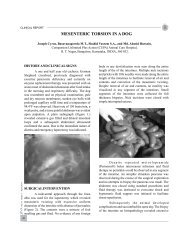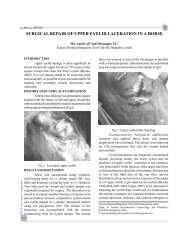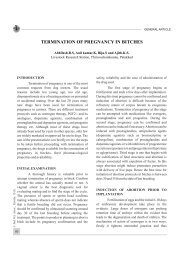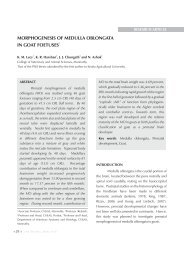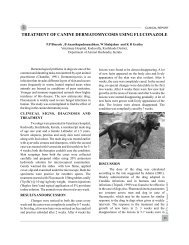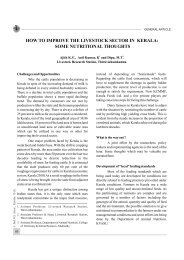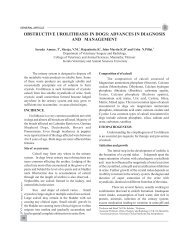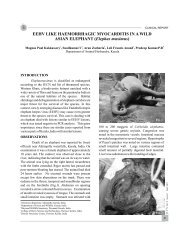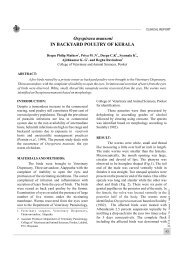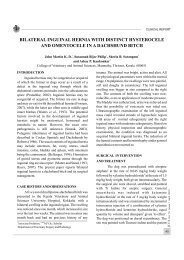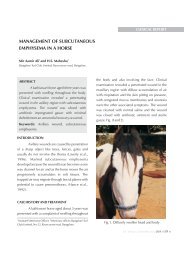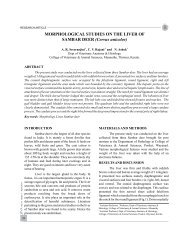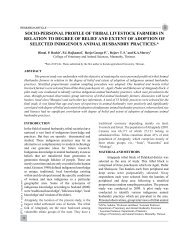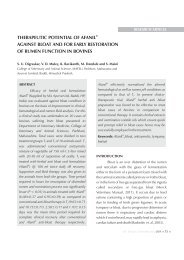2012 Jiva April Cover 220 GSM Art Card Glossy ... - Jivaonline.net
2012 Jiva April Cover 220 GSM Art Card Glossy ... - Jivaonline.net
2012 Jiva April Cover 220 GSM Art Card Glossy ... - Jivaonline.net
Create successful ePaper yourself
Turn your PDF publications into a flip-book with our unique Google optimized e-Paper software.
RESEARCH ARTICLEMOLECULAR DETECTIONOF PORCINE FOOT BUSH WITH ANAEROBIC ETIOLOGIES1 2 3 4 5Liya Anto , Siju Joseph , M. Mini , Sheethal. G. Mohan , S. Vamshi Krishna ,6 7Abraham Joseph Pellissery and A. P. UshaCollege of Veterinary and Animal Sciences, Mannuthy.ABSTRACTFoot bush in most instances is more comparable to foot abscess in pigs. Foot rot is primarily causedby damage to the hooves or the tissue surrounding the hooves, which allows a bacterial infection to set in anddevelop. Multiple etiologies are involved in the commencement of this disease, which include both aerobicand anaerobic organisms. The most commonly detected anaerobic etiology in foot rot in pigs isFusobacteriumnecrophorum (F. necrophorum), followed by Dichelobacternodosus (D. nodosus). There wassevere lameness in pigs characterized by separation of hard horny wall from the heel, oedema andabscessation. 26 cases of pigs which showed severe foot lesions were reported, of which ten representativesamples were collected. All samples were processed and DNA was extracted. They were subjected topolymerase chain reaction using species specific 16S r RNA and lktA gene primer pairs for D. nodosus and F.necrophorum respectively. Out of the samples screened, none were positive for D. nodosus and two yielded anamplicon size of 402 bp of lktA gene indicating the presence of F. necrophorum.INTRODUCTIONFoot bush, which is also known as footrot inpigs is similar clinically to footrot in other species,like sheep, goat and cattle. Foot lesions are commonand have been reported in all age groups ofswine(Mouttotou et. al., 1999). But footrot isrelatively not common in pigs as compared to otherspecies. Factors which predispose pigs to foot bushinclude rough and abrasive flooring, wet underfoot,dietary deficiency and dirty environments(Mouttotou et. al., 1999; Radostits et. al., 2000).Foot bush in pigs is caused by multiple bacterialetiologies. Detection of Fusobacteriumnecrophorum (Zhou et al., 2010), Dichelobacternodosus,Staphylococcus spp., Streptococcus spp1,2,3,4,5Department of Veterinary Microbiology, College ofVeterinary and Animal Sciences, Mannuthy.6Department of Veterinary Biochemistry, College of Veterinaryand Animal Sciences, Mannuthy.7Centre for Pig Production and Research, College of Veterinaryand Animal Sciences, Mannuthy.(Teshale, 2005), Arcanobacterpyogenes(Radostits, 2000), Prevotella, Peptostreptococcus,Porphyromonas, Bacteroides and Eubacterium(Piriz et. al., 1996) from the lesions of limbs of pigshave been reported. Among these, two species ofanaerobic bacteria are constantly found associatedwith foot bush in pigs: Fusobacteriumnecrophorum (Radostits et. al., 2000; Zhou et. al.,2010) and Dichelobacternodosus (Radostits et al.,2000; Teshale, 2005).Traditionally the identification of D.nodosus and F. necrophorum are carried out byisolation of the organism from the hoof of affectedanimals, its staining and biochemicalcharacterization (Kortt et. al., 1983; Skerman,1989; Smith et. al., 1991; Falkler et. al., 1999).Isolation of these bacteria from clinical samples isless confirmatory, very difficult, time consumingand require additional growth supplements (Smithet. al., 1991; Falkler et. al., 1999; Gradin andJIVA Vol. 10 Issue 1 <strong>April</strong> <strong>2012</strong>13



